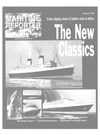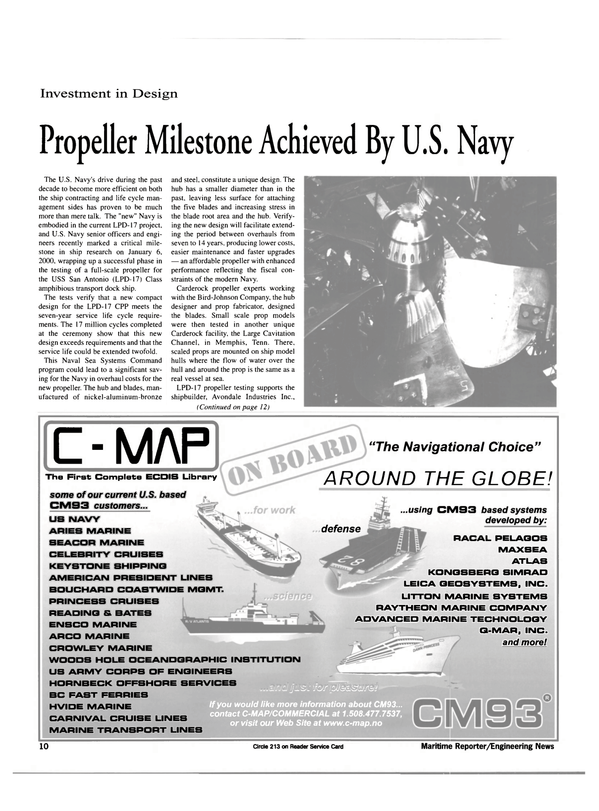
Propeller Milestone Achieved By U.S. Navy
The U.S. Navy's drive during the past decade to become more efficient on both the ship contracting and life cycle management sides has proven to be much more than mere talk. The "new" Navy is embodied in the current LPD-17 project, and U.S. Navy senior officers and engineers recently marked a critical milestone in ship research on January 6, 2000, wrapping up a successful phase in the testing of a full-scale propeller for the USS San Antonio (LPD-17) Class amphibious transport dock ship.
The tests verify that a new compact design for the LPD-17 CPP meets the seven-year service life cycle requirements.
The 17 million cycles completed at the ceremony show that this new design exceeds requirements and that the service life could be extended twofold.
This Naval Sea Systems Command program could lead to a significant saving for the Navy in overhaul costs for the new propeller. The hub and blades, manufactured of nickel-aluminum-bronze and steel, constitute a unique design. The hub has a smaller diameter than in the past, leaving less surface for attaching the five blades and increasing stress in the blade root area and the hub. Verifying the new design will facilitate extending the period between overhauls from seven to 14 years, producing lower costs, easier maintenance and faster upgrades — an affordable propeller with enhanced performance reflecting the fiscal constraints of the modern Navy.
Carderock propeller experts working with the Bird-Johnson Company, the hub designer and prop fabricator, designed the blades. Small scale prop models were then tested in another unique Carderock facility, the Large Cavitation Channel, in Memphis, Tenn. There, scaled props are mounted on ship model hulls where the flow of water over the hull and around the prop is the same as a real vessel at sea.
LPD-17 propeller testing supports the shipbuilder, Avondale Industries Inc., and Bird-Johnson. The overall effort began at Carderock headquarters, Bethesda, in October 1998 and is a fouryear, $2.8 million program involving both structural and hydrodynamic research and development.
The Carderock Division, with its unique laboratories and test facilities, large-scale land-based engineering and test sites, and at-sea measurement facilities, is and has been at the forefront of technologies vital to the success of the Navy and maritime industry for more than a century. The key element in the technological success of the Division is the breadth and depth of its capabilities.
The Division provides cradle-to-grave support for its technical products over an enormous breadth of scientific areas related to surface and undersea platforms.
Today, the Division is applying its expertise to ensure that the Navy maintains tactical superiority in the most cost-effective manner. Such work embodies "core equities" of the Naval Sea Systems Command (NAVSEA) helping fulfill a unique roll in Defense Department acquisition strategy.
Read Propeller Milestone Achieved By U.S. Navy in Pdf, Flash or Html5 edition of February 2000 Maritime Reporter
Other stories from February 2000 issue
Content
- Bergesen Orders Four Tankers From Hitachi page: 7
- Chuan Hup Unit Secures PB Contract page: 7
- A model approach from the Swedes page: 8
- Innovative class for the banana trade page: 9
- Propeller Milestone Achieved By U.S. Navy page: 10
- Propeller & Shafting Symposium Planned page: 11
- PropacRudder Benefits Confirmed In Service page: 12
- E&P Spending 2000: Boom or Bust? page: 14
- New Government Statistics Show Larger, Diverse Fleet page: 15
- ATB Delivered by Alabama Shipyard page: 16
- Cruise Shipping Annual The New "Class" of Celebrity's Class page: 19
- Cunard Creates The Classic Liner (Again) page: 24
- Cruise Industry Leaders To Convene At SeaTrade page: 25
- Cruise Share Performance page: 26
- Litton Marine Systems Supplies IBS Order page: 27
- MSC Europe Experiencing Steady Growth Stream page: 27
- James P. Colie Completes Cruise Ships Refurbish page: 29
- New Cruise Ship Designs Impact Terminal Ops And Logistics page: 31
- Royal Caribbean Commits To Environmental Endeavors page: 34
- Superseacat Service To Be Launched page: 35
- Strong Finish To A Strong Year In Oslo page: 37
- New MaK M 43 Series Aids German Branch page: 38
- Isotta Fraschini Marine Diesel Engines Available on W. Coast page: 38
- DeJong & Lebet Assists On Vessel Conversion page: 40
- Coastal AIS Stations with Radars: High-Efficiency Monitoring Facility page: 44
- Supporting The Technical Revolution page: 46
- Cadkey 99 Offers Powerful Features page: 48
- Where Businesses And Consumers Can Mix page: 48
- BT Unveils E-Commerce Site page: 48
- Finnish Innovation Ascends New Heights page: 50
- AKER FINNYARDS page: 50
- Keeping Machinery Spaces Safe page: 53
- Kvaerner Masa-Yards Delivers page: 54
- Record Trade Surplus Boosted By Shipsales page: 55
- Allied Systems Delivers SOLAS Approved Davit page: 55
- GDHS Launches Friobox Express page: 56
- Schoellhorn-Albrecht Supplies Deck Equipment page: 58
- Golden Ocean Reaches Agreement; Announces Resignation page: 58
- GD Appoints Welch As Snr. VP page: 60
- Furuno Introduces CH-37 Sonar page: 60
- STN Introduces New Speed Log page: 60
- NASSCO Lands First Phase Of Ship Conversion page: 65
- Derecktor Shipyard Wins Contract For Two Pilot Boats page: 66
- Gladding-Hearn to Deliver Largest Incat Fast Ferry page: 67
- Bollinger Launches Ocean Intervention II page: 70
- SeaArk Delivers Commander To Passaic Valley page: 70


